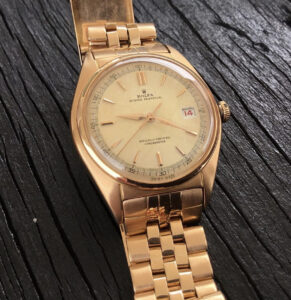In depth review Datejust: A closer look at a Rolex Icon Part 1
Fine WatchesCollector's InsightHonestly speaking I was not always a fan of the Datejust.
In the beginning I thought it was the ‘poor man’ day-date. That had three reasons. 1) For my taste, day-dates were simply more beautiful, as my father had one 2) Rare and expensive day-dates continue to fetch stronger prices than Datejust at auctions all things considered. 3) The Datejust really still stands in the shadow of other Rolex models. And not much is written about it either. So, I figured it was just a model that Rolex came out with, but not very important.
How wrong I turned out to be!
With time and the more knowledge I gained, I realised that the Datejust is a titan of a watch. Davide Parmegiani said it well when I asked him what makes the Datejust special: ‘It represents the essence of timeless elegance, suitable for any use from a sporty look to a black-tie event. The Datejust is and will remain one of the iconic designs of the 20th century.’
This two-part report on the Datejust will show Rolex at its best and shed light on why today the Datejust remains one of the most iconic lines in the history of watches!
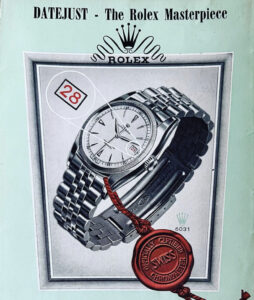
(An ad showing off a Rolex innovation of date-window in an oyster perpetual self -winding /probably 1949/50. Notice the model they are showing: Ref 6031). Credit: Darkimperator
Before I go into the datejust report- I just want to clarify what this post is meant to be.
It will not be a comprehensive report on all datejust models. You can go and buy a book for that. What it will be is the following: my favourite early Datejust models, all from the late 1940’s to the early 1960s. Le Monde Edmond always has been about my taste in a certain period of time and I don’t intend to change that. Like many Rolex models, I believe that most of them are less attractive as time goes by, so pretty much everything made after the late 1960’s is not appealing in my view (the Daytona might be one exception).
Since I have always only written about what I love, this Datejust report is very specific and targeted. Let’s get started.
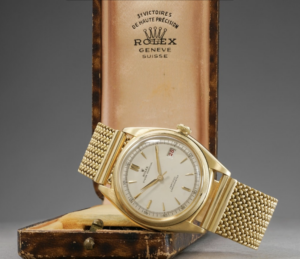
(An early datejust Model ref 4467 late 1940s. Credit: Phillipswatches).
An icon for Rolex.
Released for the 40th anniversary of Rolex in 1945 it the first wristwatch with a chronometer rating to display a date window with self-winding movement. Now today we take this for granted but think back to 1945, wristwatches were young and a date-window was a true innovation. When I think about Rolex and what it stands for and why it is so successful today it is often for one thing besides great design and marketing: innovation.
When Rolex brought out the Datejust it was just another milestone in proving no other watch manufacture was as innovative as Rolex.
With time the datejust became so popular- that today it is the oldest model line still being produced by Rolex. The datejust that I intend to cover in this report are only the early models, but they are in my opinion the most beautiful. There are 12 references that belong to the early datejust. They are in order of release:
Ref 4467 – 5030 – 6030 – 6031 – 6074 – 6075 – 6104 – 6105 – 6304 – 6305 – 6309 – 6605.
Part 1 will be dedicated to 4467 until 6105 which for me is the last of the old school pre-datejust models. In Part 2 I will cover the 6105 diamond dials up until the 6605.
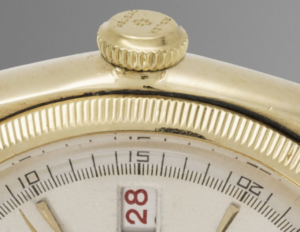
(The Datejust with date window – which was a Rolex first innovation / Credit: Phillipswatches).
The Datejust was marketed for leaders of industry, kings and prime ministers & Presidents.
When Rolex came out with the Datejust it was aimed at the top leaders of the country, wether in politics, business or sports. President Eisenhower is known to have owned one as was Winston Churchill, King Hassan II of Morocco, the Pope and Sammy Davis Junior.
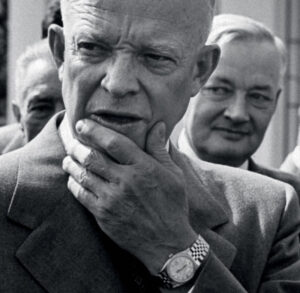
(President Eisenhower wearing a Datejust Rolex).
The late King of Morocco Hassan II is known to have loved Rolex. He had an extensive watch and Rolex collection which I intend to cover in a blog post soon. In the picture below he is seen hunting in 1960 with the King of Jordan. On his wrist is a Rolex Datejust.
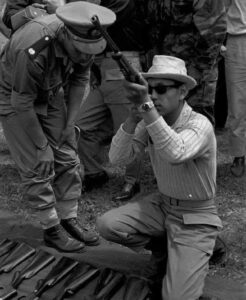
(Credit: Getty Images).
Another well known global figure Sir Winston Churchill had very concrete ideas how he wanted his Datejust to look like and what material he wanted. Below a letter to Hans Wilsdorf concerning his datejust.
![]()
Churchill wanting the emblem of his family on the caseback and the material to be pink gold.
![]()
(Credit both pictures: Zinhwatch).
In fact Rolex themselves provides some clues in their official advertising who the Datejust market was aimed at: Leaders of industry.
Below we have the president of Republic Aviation (a company with 22’000 employees at the time) Mr Mundy Peal wear a datejust. Republic Aviation was one of the largest Aerospace companies in the world at the time, supplying the US airforce with fighter jets. Pay attention to the interesting Rolex crown on the datejust watch in the ad below.
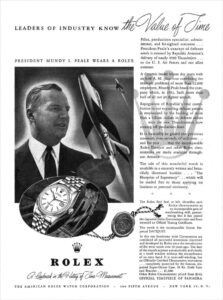
(Credit: Unknown).
Another CEO who choose to wear a Datejust was Mr. Douglas who was President of McDonell Douglas (see advert below) wearing a Datejust too.
I find it fascinating and perhaps not without coincidence that both were CEO´s of large companies in the Aerospace industry. Given that a Rolex Datejust with gold jubilee bracelet was $1’000 back in the late 1940s (see ad below that mentions the $1’000 price tag) it becomes clear that only extremely successful people could afford such a watch (the average yearly income for family in the US was $3’100 in 1949).
What is also interesting to observe is that Rolex mentions Datejust in their advertising, but there is no mention of the Datejust on the first Datejust Rolex watches shown in the ad.
Indeed as we will see later in the report, it took Rolex a few years before they would formally put Datejust on the dial with ref 6105 (and only the later ones of that reference).
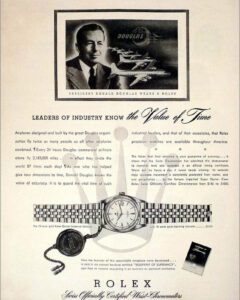
(Credit: Darkemperator).
Below a 1950’s price list showing the 18kt Datejust with jubilee costing GBP 289 (note the GBP was stronger than the USD also in the 1950s).
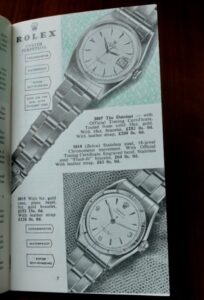
(Credit: Rare & Fine WS).
Why the Datejust is called the big bubbleback or Ovettone & it’s place in Rolex history.
The Italians have nicknamed the datejust, Ovettone for its shape that looks like an egg with its bubbleback type caseback.
With good reason. The datejust is in many ways the successor to the Bubbleback. There are indeed many similarities including similar Rolex crowns on the dial with the early datejusts (like the one below), and similar case-backs. No wonder collectors often call the datejust – the big bubbleback or Ovettone.
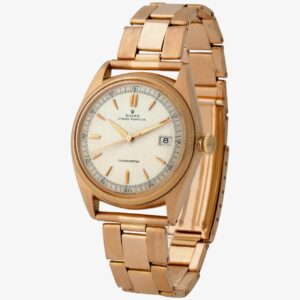
(A fine pink gold 4467 datejust with early serial 460xxx / Credit: Monaco Legend Group).
The very first datejust is Ref 4467 which came out in 1945.
It was available in a variety of materials (gold, pink gold). The very first batches have the serial number engraved on the case-back rather than between the lugs. The serial number can be seen engraved on the casebook below (460 6xx). The dial color seemed to be standard in terms of color (white) but there are small difference in text which we will get into later. On the subject of dial color, I have heard of 4467 black dials (from very good sources and I show one under the wrist shots section below), however I have not seen one yet in person and if they are around they are extremely rare.
The 4467 early watches have what appears to be like a two-tone dial (see above) with the color other dial changing slightly where the minute track is in Arabic numerals font.
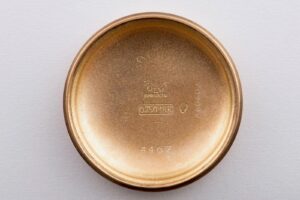
And between the lugs where the serial is normally seen, is written Modele Depose.
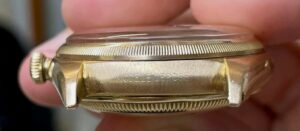
This early pink gold datejust is powered by a calibre A295 an automatic movement with super balance rotor.
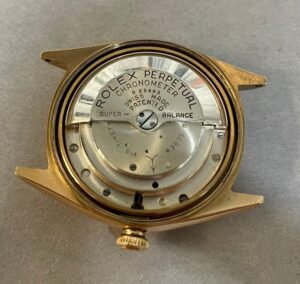
(Credit: All three pics above Mauricedeangelis).
The actual caseback of the 4467 is similar to the bubble backs that came before this reference. This is why collectors call many early datejust models ‘The Big Bubbleback‘ or Ovettone (large egg). Below a fine example in pink gold. Notice the bulgy caseback. It is indeed because of this bulge that Italians of nicknamed the Datejust Ovettone (egg like).
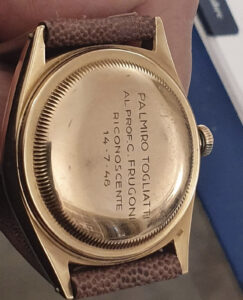
(Credit: Private Italian collector GT).
Regarding the ‘famous’ date wheel (after all the Datejust was the first watch to show the date) what is correct? I have consulted a Japanese Gentlemen collector and expert and he has given me the following advice:
- Very first batch of 4467 delivered all black date wheel
- From 1945-47 the date wheel should be all red
- From 1947-53 the date wheel should be either roulette (red and black) or all red
- From 1953-58 the date wheel should be roulette
- After 1959 all black date wheel
Other details I noticed with the 4467 are the following: 1) some dials are signed only Chronometer (like the one above) while some are signed ‘certified chronometer’ (like the one below). 2) In terms of Rolex crowns seen on the dial I there seems to be two types: the bubbleback type one; and the cut off Rolex crown (type 2). 3) Reg the signature on the dial, the most common correct in my view is the ‘Swiss Made’ signature.
Lastly there are a multiple of dial variations seen. With luminous, without lume, triangular indexes, bullet type indexes (like below). All seem to be correct as they were many dial types (I will show a few under wrist shots towards the end of my report).
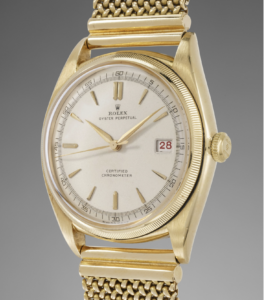
(Early datejust ref 4467 with red date, and bubbleback type crown dial, serial Nr 518xxx / Credit Phillipswatches).
Below the serial number now found between the lugs even if it’s very close to the other 4467 shown above with serial 460 xxx.
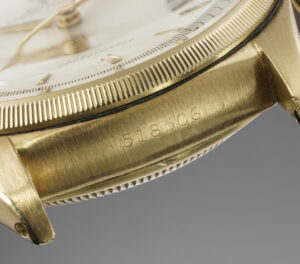
(Credit: Phillipswatches).
The winding crown of the Rolex 4467 is Rolex + Oyster (with the + sign in the middle).
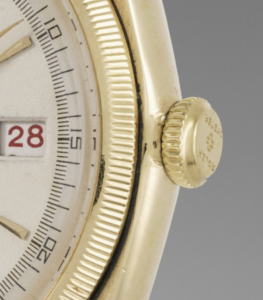
(Credit: Phillipswatches).
Details of the finely milled or fluted bezel of the 4467 below, which is typical of the 4467.
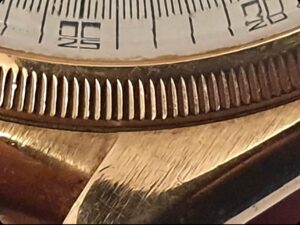
Credit: Italian private collector GT.
Below a nice picture of various parts of the first Rolex Datejust ref 4467. Notice the finely milled bezel insert (top right) that would later change with the ref 6305 to a more broad fluted bezel.
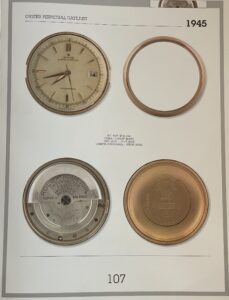
(Credit: The Rolex Story, Mondani Press p107).
All datejust models Ref 4467 have the following common traits however:
- All watches without exception don’t have the ‘Datejust’ written on the dial (that would be appear in Ref 6105), but simply ‘Oyster Perpetual’.
- Every model 4467 has a thin milled bezel which would later change to the wider gapped fluted bezel starting with ref 6305.
- Most winding crowns of the 4467 tend to have the Rolex + Oyster written on the winding crown.
- Most if not all 4467 Datejust models were offered with the Jubilee bracelet in gold (see Rolex ad below).
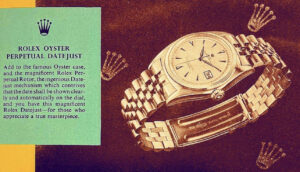
(Credit: Unknown).
Although, again here there are exceptions that can be seen: I have witnessed an early datejust in Pink gold supplied with the so called Mecan bracelet made for Rolex which is an oyster bracelet. If the watch originally came like that is not clear though.
Co-incidentally these bracelets were also supplied for Rolex bubble backs and therefore could be correct given that the first large Bubbleback with date is ref 4467. I should also add that the Rolex often did not sign these early bracelets with a date (contrary to the Jubilee bracelets) which tend to be signed and dated.
In 1948 Rolex brings out the 5030
While the 4467 is an Icon among date-just there are many other important early date-just models. One the most unusual but beautiful is Ref 5030.
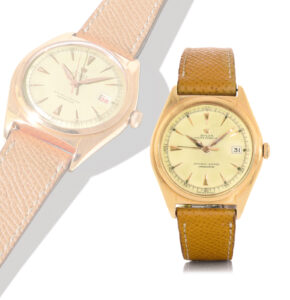
(A 5030 Rolex with type 2 dial, Credit: Meetingart watches).
Collectors will immediately notice the unusual case design of the 5030 which collectors have also nicknamed Ovettone. Indeed ref 5030 is unlike any other Datejust that would come later.
The case design is radically different from anything before 4467 and all that came after (6030, 6075, 6105 etc). Also notice the smooth bezel versus the milled bezel for the 4467.
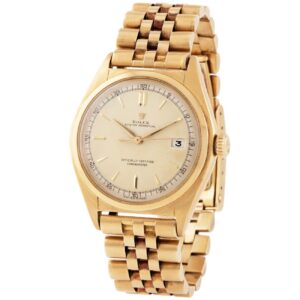
(A beautiful view of the 5030 with Jubilee bracelet with type 2 dial /Credit; Monaco Legend Group). Serial 658 xxx
The 5030 was made during the late 1940s for only an extremely short period of time; according to reliable sources I have spoken to, some say only for one year in 1948.
The case appears to be smaller than the 4467 before it with a 35.5mm case versus 36mm for the 4467. In terms of case material it was made in gold and pink gold. Movement seems to be the same as 4467 with A 295 calibre (see picture below). Additionally, most examples I was able to find are in serial number range 650 – 670 xxx range (so a fairly tight range).
It seems the 5030 came with two dial colors, white and black (with the latter being far more rare).
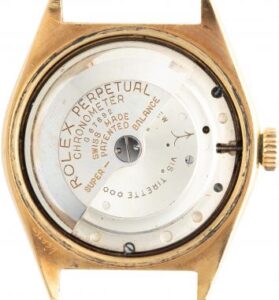
(The unusual case design is especially noticeable looking at the back of the 5030).
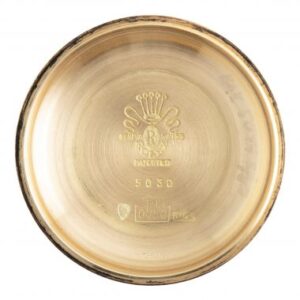
(Caseback of the Rolex 5030/ Credit: MonacolegendGroup).
Before I go into the different type of dials seen for the 5030, allow me to share this beautiful pink gold version that was sold at Christies in 2008. Serial Nr 605 xxx. Clearly collectors back in 2013 did not realise the rarity and beauty of the early 5030 Datejust.
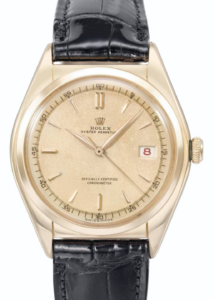
(Credit: Christies).
There seem to be three type of dials for this reference that are most seen:
- The Rolex bubbleback type crown dial, a so called type 1 dial.
- The cut-off or truncated Rolex crown or type 2 dial
- A Full Rolex crown or type 3 dial.
I show all 3 types below:
(Type 1 dial or first generation Rolex BB type crown dial / Credit: Mariodisette). Serial Nr 628 xxx
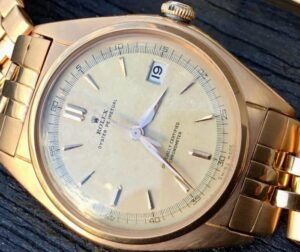
(Type 2 dial or second generation with cut-off Rolex crown /Credit: Phillipswatches). Serial 648 xxx

(Another type 2 dial with cut off Rolex crown in pink gold with super rare black dial /Credit: John Goldberger 100 Rolex App). Serial 672 xxx.
This watch is also the front cover picture of this blog article. A Le Monde Edmond type of watch!
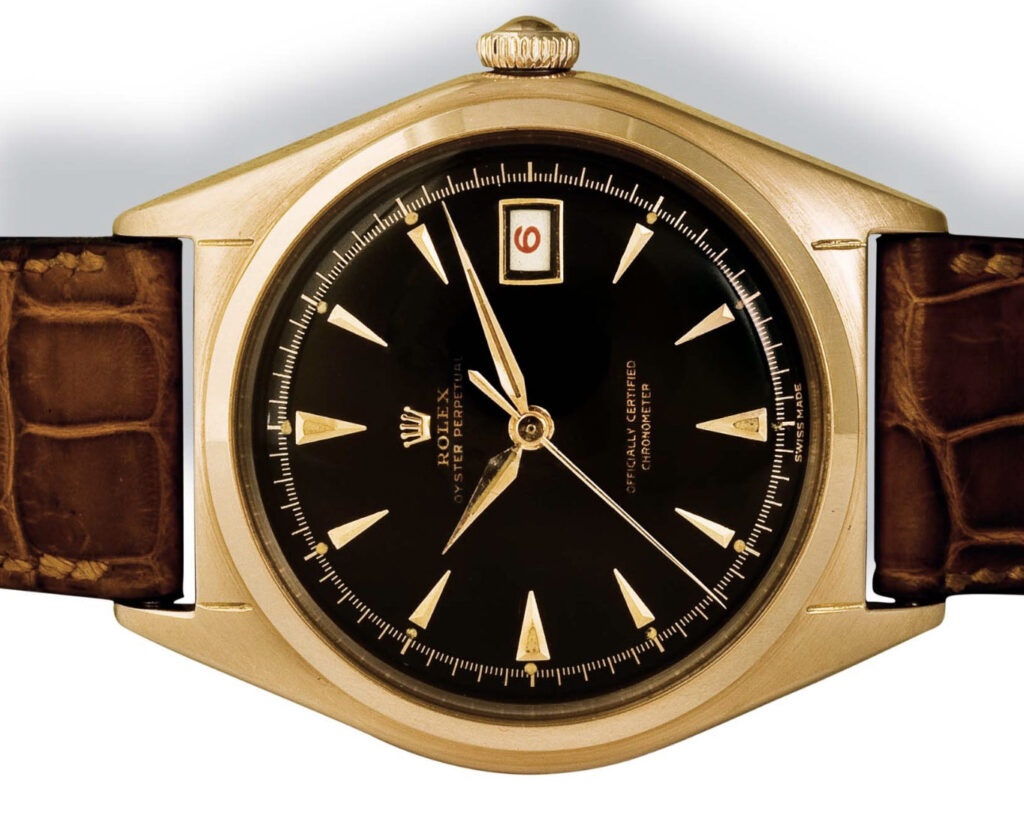
(Type 3 dial or third generation with full Rolex crown shown/ Credit: Antiquorum). Serial Nr 663 xxx
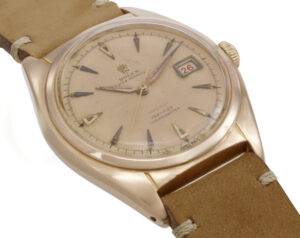
The 5030 is somewhat of an outlier for Rolex date-just, and that is exactly why I love it.
It has a smooth bezel, unusual case design and would look nothing like the previous datejusts or ones that came after (the 6030/31). I personally find it a beautiful and compact Datejust with the smaller case and unusual case design. The fact that was made for such a short period of time increases the attractiveness of the watch for me.
The elusive Date-just models Ref 6030/31 in 1949
The earliest 6030 seem to have come around 1949 (so one year after the 5030). With the 6030/31, we revert optically to the first datejust again, the 4467.
Noticeable are a few things: Similar case design. Roulette type or red type date wheel. Also, we go back to the milled bezel.
Frankly, the problem is that the datejust 6030/31 are so rare that I cannot write anything constructive about it. How rare is the 6031? Well, the last time I could find one that sold at auction was in 1989 at Antiquorum. Yup 1989, that is 33 years ago. A rare left-hand model 6031 seemed to have sold at Christies in 2005. I cannot judge the correctness of this watch however as the picture is too unclear.
The Rolex 6031 (middle watch Lot Nr 1872) is also left handed making it even more exclusive.
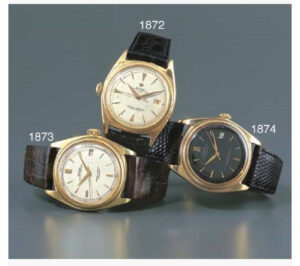
(Credit: Christies).
Now there seemed to have been a few private sales of these watches. One of them is in pink gold (extremely rare) once owned by an Italian dealer in Miami.
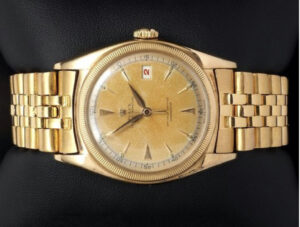
(Credit: Vintage watches Miami).
The last 6031 I can share with you is from an Italian private collector who has an exceptional date-just collection.
Below an incredibly rare 6031 also in pink gold in what seems like exceptional condition. The watch below stands further out for its double signed signature Serpico Y Laino. What a dream watch!
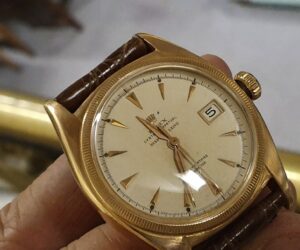
(Credit: Private Italian Collector GT).
The Ref 6075 – The last ‘old school’ Datejust or Ovettone
One of the most beautiful early Rolex date-just has to be the Ref 6075.
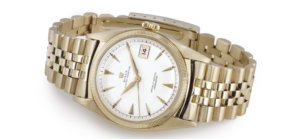
(A breathtaking datejust ref 6075 with serial Nr 685 xxx with type 1 dial/ Credit Christies).
The ref 6075 came in the early 1950’s and replaced the 5030 & 6030/1. The 6075 is noteworthy in the history of datejust for a few reasons.
- In my view it is the last reference to carry the Swiss Made on the dial (6105 would transition to Swiss).
- It is also in my view the last reference datejust to carry the old fashioned or cut- off Rolex crown on the dial.
- Super Important point: The last Rolex not to carry the name datejust on the dial! Everything after this reference would appear more modern and the dial configuration completely different in many ways.
The 6075 was made in both pink gold and gold. Dial colours made were both white and black.
In terms of dial, let’s look at one in pink gold. Early dial Swiss Made and cut off crown naturally. Serial Nr 714 xxx
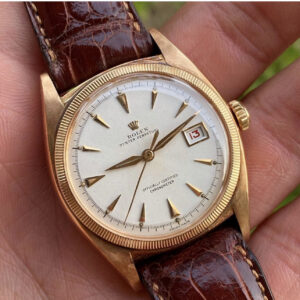
(Credit: Maurideangelis).
Notice how the winding crown has changed from the 4467. The + sign on the edge now along with the writing.
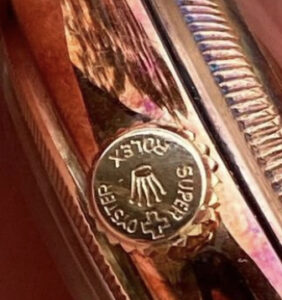
A few things are noticeable here.
- First is the cut-off crown and no mention of datejust on the dial.
- The dial is signed Swiss Made which is correct.
- Red date wheel.
- The fine milled bezel again.
- The winding crown which now displays the super oyster crown (similar to the 8071 padelone and 6062 oyster).
Below is the very same dial type but with the hyper rare black dial. Notice Swiss Made signature and cut off crown. This watch is important as very few 6075 are known with black dial. Owned by a Japanese collector.
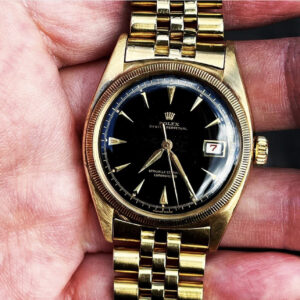
(Credit: Tenggang / Japanese collector).
Another version of an early dial with cut off crown below in Yellow gold can be seen below. It was sold by Phillips in 2015 for CHF 11k. Serial Nr 714 xxx. I point this out also because I think it shows you just how inexpensive these rare Datejust were going for.
Today you could not even buy the bracelet for this amount, let alone the watch.
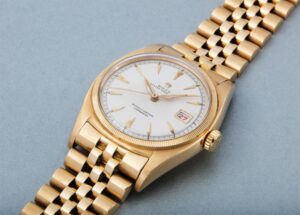
(Credit: Phillipswatches).
Below more details of the elusive 6075 with the jubilee bracelet.
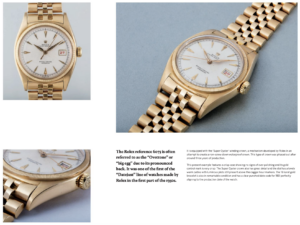
(Credit: Phillipswatches).
The movement of the 6075 datejust was powered by the A 296 calibre.
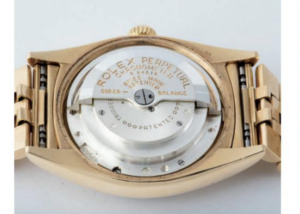
(Credit: Phillipswatches).
Prices have slightly improved, but they are still not where they should be! How do I know this?
Take a look at this 6075 black dial (the rarest dial variant for a 6075) that sold at Antiquorum just barely one year ago in January 2021- it sold for €19’500. Not very much considering the rarity of the reference (6075) and the rare black dial and a gold jubilee that was signed (but not dated). I cannot see the Swiss Made signature on the dial however (it should be Swiss Made signed).
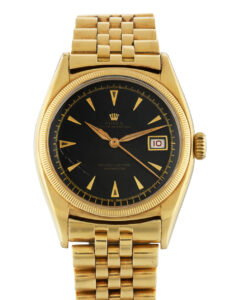
(Credit: Antiquorum).
An important comment is in order for some later dials seen on the 6075.
I have seen from relatively well-known collectors / collections some 6075 with 1) datejust written on the dials and 2) Swiss only signed. I believe both of these would come first later with the 6105 and 6105-1.
The King of rarity datejust 6074 platinum made in 1950.
My report is focused on gold or pink gold datejust. But I have to pay tribute to one particular outlier in the datejust world – the 6074 in platinum.
According to John Goldberger only two were made and one of them is missing. Which leaves this particular version below. Made in 1950 in two examples, the watch is unique in a few ways: 1) unique platinum case material 2) caseback and oyster bracelet also platinum 3) the dial in honeycomb and hands made in white gold with lume.
Below the honeycomb dial with white gold hands.
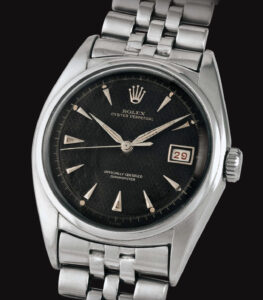
(Credit: John Goldberger Rolex App)
The proof that this material is platinum (PT 950) – an extreme rarity for the early datejust.
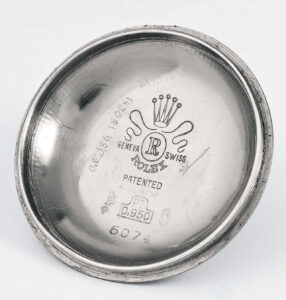
(Credit: John Goldberger Rolex App)
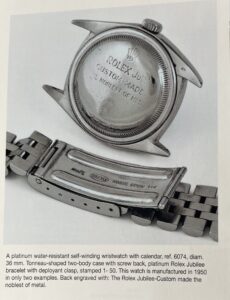
(A unique piece made by Rolex as written on the caseback of this 6074 datejust in Platinum/ Goldberger 100 Rolex book P164).
Closing comments
The 6075 is the last early old school Rolex Datejust or Ovettone.
The next model 6105 and onwards will have many details that represent a more modern datejust even if they are still very vintage. The Rolex crown, Swiss signed dials and will be all very different but no less charming. Early Datejust listed here represent some of the most interesting and rare watches Rolex ever made.
First, because they are a landmark in wristwatch development. The first watch with a date indicated on the dial of any manufacturer. Secondly, they were made for the traveler and connoisseur that wanted an elegant watch with automatic movement, something that many other brands like Patek were not yet offering during this time period. Third, all these early Datejust or Ovettone can be bought still for relatively little money.
In my view that is because they are not that well known to the new generation watch collector. With time this will change, and they will become recognised for their beauty, importance and timelessness.
NB: I would like to thank the following collectors who have helped me with their knowledge for this report in Part 1. They are Shuichi from Japan, Mario Dissette and Giorgio T from Roma. Also thank you Wulf (Rare & Fine) for your input. Allow me to share some wonderful wrist shots of these early Datejust.
An exceptional pink gold 4467 with Mecan bracelet made for Rolex also in pink gold (Credit: Mauricedeangelis).

A very fine pink gold Ref 4467 so first model Datejust. Notice the type 2 dial and roulette type date wheel. (Credit: GM).
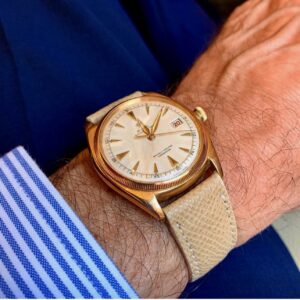
Another fine pink gold 4467 with type 1 dial – notice the crown that is similar to Bubblebacks. (Credit: GT).
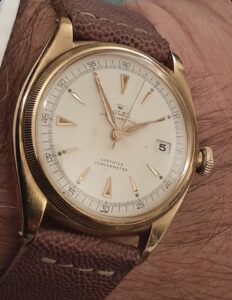
An extremely rare black dial version of the 4467. Notice the Swiss Made signed dial. (Credit: GT).
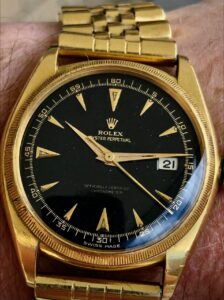
A superb 6075 in pink gold owned by an Italian collector. (Credit: GM).
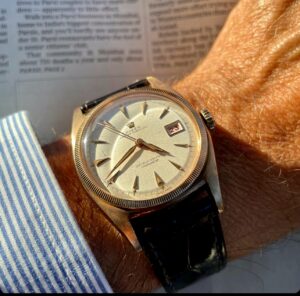
A very rare and elusive and fine 5030 in pink gold. (Credit: Mario Dissette).
